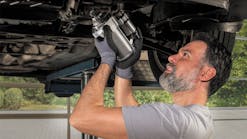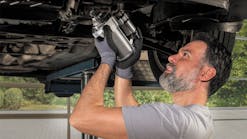Cummins Filtration now utilizing beta ratio to rate fuel filtration effectiveness
Cummins Filtration has begun applying the scientific measurement of Beta Ratio to more accurately benchmark and convey the filtration capability of the highly technologically-advanced filtration media that make use of the company's patented nano-fiber technology.
Beta Ratio is the most accurate means for communicating the effectiveness of a filtration media and predicting its actual service performance out in the "real world."
Beta Ratio equals the number of fine particles that a filter is able to remove for every one that manages to escape through the filter. It is determined for specific sizes of harmful particles. In this example, the Beta Ratio compares the number of particles entering a filter media (the "dirty" upstream side) to those exiting the filter medium (the "clean" downstream side):
- A Beta Ratio of 2 = 100,000 upstream particles/50,000 downstream particles = 50 percent efficiency
- A Beta Ratio of 100 = 100,000 upstream particles/1,000 downstream particles = 99 percent efficiency
- A Beta Ratio of 1,000 = 100,000 upstream particles/100 downstream particles = 99.9 percent efficiency
- A Beta Ratio of 10,000 = 100,000 upstream particles/10 downstream particles = 99.99 percent efficiency
Clearly, the difference between a 99 percent and a 99.99 percent efficient filter is substantial, (by a factor of 100). By making use of the accurate Beta Ratio measurement when testing filtration media performance for microscopic particles, Cummins Filtration customers are ensured a superior standard for protection against harmful contaminants within an engine's fluids that could lead to additional costs in the form of needless engine wear, repairs or a decrease in fuel economy.
Cummins Filtration's revolutionary new fuel filtration media can trap contaminants below 4 microns – particles smaller than red blood cells (typically 6 – 8 microns in size). It also retains those and larger particles at much higher levels of Beta Ratio than competitive products.
Modern diesel engines equipped with high pressure common rail fuel systems (HPCR) that operate at pressures exceeding a whopping 29,000 psi require an unprecedented degree of fuel cleanliness.
Remarkably, the World Wide Fuel Charter (WWFC) has determined that fuel dispensed from at least 50 percent of retail fuel pumps around the globe do not meet the necessary cleanliness level of "ISO 18/16/13" described in International Standard ISO 4406.
Cummins Filtration's extensive research on the matter have determined that, while bulk fuel filtration is desirable to aid in helping to control fuel contamination levels, there is no substitute for effective on-engine fuel filtration.
While many fuel filter manufacturers test their products under controlled conditions in the laboratory, Cummins Filtration develops their filtration media/filtration products through rigorous testing in the field, subjecting their products not only to heavy dust and dirt exposure, but also to heavy vibration as equipment is operated in the "real world."
The result is an exceptional level of engine and fuel injector protection from water (free and emulsified), organic (waxes, residual from refining fuel) and inorganic (dirt and wear metals within the system) contaminants in your tractor-trailer, power generator or skid steer whether operated on-highway or off.
For more detailed information on Cummins Filtration products for your equipment, please refer to the FleetGuard Technical Information Catalogue (LT32599) or CD (LT36056), visit Fleetschool at cumminsfiltration.com or contact your local Cummins Filtration product expert for assistance.

